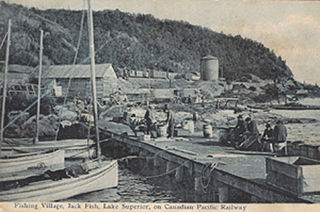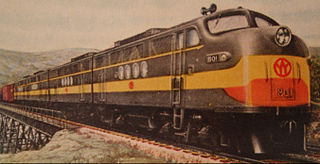
The Grand View Beach Railway was a scenic electric street railway along the shore of Lake Ontario from the village of Ontario Beach, a suburb of Rochester, to Manitou Beach.

The Grand View Beach Railway was a scenic electric street railway along the shore of Lake Ontario from the village of Ontario Beach, a suburb of Rochester, to Manitou Beach.
The railroad was 8 miles (13 km) long. For several miles out of Ontario Beach the road ran along a bluff close to and overlooking the expanse of Ontario and about 15 feet (4.6 m) above the level of the water. From Rigney's Bluff westward to Manitou the track threaded a sandy beach between the great lake and various little bays and ponds. [1]
0. Siding #1, Spitz Hotel, 160 Beach Ave.
1. Wilder Terr.
2. Hospital, Rear Summer Hospital for Children
3. Cloverdale Farm City line - Spur to water works - was siding #2
4. Little Pond
5. Rigney's Bluff (Shoremont)
6. Siding #3
7. Fehrenback's Lake View Hotel Adolph Grossmans Hotel at Round Pond Outlet Breakers
8. Island Cottage on left - Edgewater Hotel on Lakeshore (Louis Cook's)
9. Buck Pond
10. Crescent Beach-W.H. Lewis Prop. 1910 later Ray Gets Pass switch siding #4
11. Later passing switch, Lewis straight
12. Outlet - Long Pond, West end trestle
13. Long Pond, Grand View Beach Hotel - A. Kleinhans later Joe Rosenbach
14. Lowden Point Road
15. Siding Pass #5, Half Way
16.
17. Springwater Hotel
18.
19. Cranberry Pond
20. Siding #6
21. Braddocks Heights
22. E. Manitou
23. Elmheart Hotel
24. Passing track #7, Manitou Beach [2]
The railroad was of modern construction and equipment. The track was 45-pound steel T rail. The rolling stock consisted of 7 motor cars, five open and two closed, and 7 open trail-cars, which could comfortably seat 60 to 70 persons. Rae motors of 40-horse-power were used and the old reliable McGuire truck. [1]
The power plant was located 2 miles (3.2 km) from the eastern terminus of the railroad. It was equipped with two Thompson-Houston 8,000-Watt generators, two engines of Mclntosh-Seymour and three 100-horse-power boilers from the Pierce & Thomas shops. [1]
The car-barn, located near the power house had storage capacity for 20 cars.
While erecting the last trestle over the Braddock's Bay, a sudden storm arose, and two men working in the middle of the bay on the trestle were drowned before they could be reached by help. [4]
Some derailments and accidents occurred: Twelve people were injured and one of them died, when a crowded car derailed near Charlotte in 1902 and plunged into a gully 15 feet (4.6 m) below. In 1904, four passengers were killed and nine were injured in a collision on the line. [5]
The cars began running in June 1891, but the railroad was in an unfinished condition until about August 1. To October 1st the total earnings were $17,976.08, operating expenses $8,500.06, interest and taxes $4,010.34, surplus $4,465.14. The total number of passengers carried was 150,000. [1]
The initial officers of the company were:
The line was subsequently operated by the Rochester, Charlotte & Manitou Beach Railroad (1895-1908) and the Rochester & Manitou Railroad (1908-1925). [3] [6] The last car ran on the line in 1925. [7]

Greece is a town in Monroe County, New York, United States. A suburb of Rochester, New York, it is the largest town by population in Monroe County, and the second-largest municipality by population in the county, behind only the City of Rochester. As of April, 2020, the town has a population of 96,926.

The Broadmoor Manitou and Pikes Peak Cog Railway is a cog railway that climbs one of the most iconic mountains in the United States, Pikes Peak in Colorado. The base station is in Manitou Springs, near Colorado Springs.

The St. Lawrence and Atlantic Railroad, known as St-Laurent et Atlantique Quebec in Canada, is a short-line railway operating between Portland, Maine, on the Atlantic Ocean, and Montreal, Quebec, on the St. Lawrence River. It crosses the Canada–US border at Norton, Vermont, and Stanhope, Quebec, and is owned by short-line operator Genesee & Wyoming.

Jackfish is a ghost town in northern Ontario, Canada, located on the north shore of Lake Superior east of Terrace Bay.

The Mount Lowe Railway was the third in a series of scenic mountain railroads in the United States created as a tourist attraction on Echo Mountain and Mount Lowe, north of Los Angeles, California. The railway, originally incorporated by Thaddeus S. C. Lowe as the Pasadena and Mt. Wilson Railroad Co., existed from 1893 until its official abandonment in 1938, and was the only scenic mountain, electric traction railroad ever built in the United States. Lowe's partner and engineer was David J. Macpherson, a civil engineer graduate of Cornell University. The Mount Lowe Railway was a fulfillment of 19th century Pasadenans' desire to have a scenic mountain railroad to the crest of the San Gabriel Mountains.

The New York, Ontario and Western Railway, more commonly known as the O&W or NYO&W, was a regional railroad with origins in 1868, lasting until March 29, 1957. The last train ran from Norwich, New York to Middletown, New York, after which it was ordered liquidated by a U.S. bankruptcy judge. It was the first notable U.S. railroad with its mainline entirely abandoned.

The Otis Elevating Railway was a 3 ft narrow gauge cable funicular railroad leading to the Catskill Mountain House in Palenville, New York. For the first 64 years of its existence, the Catskill Mountain House was accessible only by a long stagecoach from Catskill Landing on the Hudson. Faced with increased competition from the Hotel Kaaterskill, Charles Beach hired the Otis Elevator Company to build a cable funicular railroad straight up the Great Wall of Manitou. Opening on August 7, 1892, the line measured 7,000 ft (2,134 m) long with a rise of 1,630 ft (497 m), a maximum grade of 34%, and an average grade of 12%. In 1904, the line was shortened and the lower trestle eliminated.

The Sacramento Northern Railway was a 183-mile (295 km) electric interurban railway that connected Chico in northern California with Oakland via the California capital, Sacramento. In its operation it ran directly on the streets of Oakland, Sacramento, Yuba City, Chico, and Woodland and ran interurban passenger service until 1941 and freight service into the 1960s.

The Lake Ontario State Parkway is a 35.05-mile (56.41 km) parkway along the southern shore of Lake Ontario in Western New York in the United States. The western end of the highway is at a partial interchange within Lakeside Beach State Park in Carlton, Orleans County. Its eastern terminus is at an intersection with Lake Avenue in the Charlotte neighborhood of the Monroe County city of Rochester. The parkway is internally designated by the New York State Department of Transportation (NYSDOT) as New York State Route 947A (NY 947A), an unsigned reference route. A short, 0.55-mile (0.89 km) connector between the west end of the parkway and NY 18 is unsigned New York State Route 948A.

Charlotte is a neighborhood in Rochester, in the U.S. state of New York, located along the western bank of the mouth of the Genesee River along the southern shore of Lake Ontario. It is the home of the Port of Rochester and Charlotte High School.

The International Railway Company (IRC) was a transportation company formed in a 1902 merger between several Buffalo-area interurban and street railways. The city railways that merged were the West Side Street Railway, the Crosstown Street Railway and the Buffalo Traction Company. The suburban railroads that merged included the Buffalo & Niagara Electric Street Railway, and its subsidiary the Buffalo, Lockport & Olcott Beach Railway; the Buffalo, Depew & Lancaster Railway; and the Niagara Falls Park & River Railway. Later the IRC acquired the Niagara Gorge Railroad (NGRR) as a subsidiary, which was sold in 1924 to the Niagara Falls Power Company. The NGRR also leased the Lewiston & Youngstown Frontier Railroad.

Streetcars and interurbans operated in the Maryland suburbs of Washington, D.C., between 1890 and 1962. Lines in Maryland were established as separate legal entities, but eventually they were all owned or leased by DC Transit. Unlike the Virginia lines, the Washington and Maryland lines were scheduled as a single system. Most of the streetcar lines were built with grand plans in mind, but none succeeded financially. A combination of the rise of the automobile, various economic downturns and bustitution eventually spelled the end of streetcars in southern Maryland.
The Hagerstown & Frederick Railway, now defunct, was an American railroad of central Maryland built in the 19th and 20th centuries.

The history of commercial passenger shipping on the Great Lakes is long but uneven. It reached its zenith between the mid-19th century and the 1950s. As early as 1844, palace steamers carried passengers and cargo around the Great Lakes. By 1900, fleets of relatively luxurious passenger steamers plied the waters of the lower lakes, especially the major industrial centres of Chicago, Milwaukee, Detroit, Cleveland, Buffalo, and Toronto.

The North Hudson Railway Company built and operated a streetcar system in Hudson County and southeast Bergen County, New Jersey before and after the start of the 20th century. It was founded by Hillric J. Bonn who became the first President in 1865 and served for 26 years until his death, and eventually taken over by the Public Service Railway. In its endeavors to overcome the formidable obstacle of ascending the lower Hudson Palisades, or Bergen Hill, it devised numerous innovative engineering solutions including funicular wagon lifts, an inclined elevated railway, an elevator and viaducts.
The Auburn Trail is a multi-use rail trail located principally in the towns of Victor and Farmington, Ontario County, New York (USA). It is approximately 11 miles (18 km) long and maintained by the Towns of Victor and Farmington and Victor Hiking Trails. The trail mostly follows the alignment of the Auburn and Rochester Railroad. Additional disconnected portions of the Auburn trail are found in the Towns of Pittsford and Brighton, Monroe County, NY. A detailed description and map of the Auburn Trail are available from Victor Hiking Trails.
The Rochester Railway Company operated a streetcar transit system throughout the city of Rochester from 1890 until its acquisition by Rochester Transit Corp. in 1938. Formed by a group of Pittsburgh investors, the Rochester Railway Company purchased the Rochester City & Brighton Railroad in 1890, followed by a lease of the Rochester Electric Railway in 1894. The Rochester and Suburban Railway was leased in 1905, extending the system's reach to Irondequoit and Sea Breeze. Rochester Railways was acquired by the Mohawk Valley Company, a subsidiary of the New York Central Railroad set up to take control of electric railways in its territory. In 1909 the holdings of the Mohawk Valley Company were consolidated as the New York State Railways.

The Rochester and Sodus Bay Railway was an electric interurban railway connecting Rochester with the shores of Lake Ontario at Sodus Point. The line was leased to the Rochester Railway Company in 1902 and later merged into New York State Railways in 1909. Ridership dropped off in the 1920s, and the railway east of Glen Haven was abandoned in 1929. The remaining local streetcar service ended in 1933.

The South Beach Branch, also called the East Shore Sub-Division, is an abandoned branch of the Staten Island Railway in New York City, which operated along Staten Island's East Shore from Clifton to Wentworth Avenue. This 4.1-mile (6.6 km) double-tracked branch left the Main Line at 40°37′08″N74°04′18″W, south of the Clifton station, and lay to the east of the Main Line.